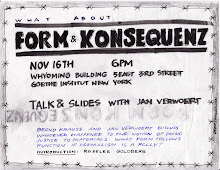Exhibition by day and theater at night, “iSLAND kEEPER” stakes out new territory for artist Bernd Krauß. A collaboration between the Center for Curatorial Studies, Bard College (CCS Bard) and Goethe-Institut New York, the show will be presented as a part of PERFORMA 09. Slotted for November 1st – 21st 2009, “iSLAND kEEPER” will be housed in the Goethe-Institut’s newly renovated Wyoming Building on Third Street, just off Bowery.
An opening reception will take place on November 1st from 12 - 4pm.
The exhibition will be on view Tuesday - Saturday, 1 - 6pm, or 1 - 7pm on days with evening performances:
Sunday the 8th: Premier of American Soldier 7pm
Wednesday the 11th - Saturday the 14th: nightly performances of American Soldier 7pm
Wednesday the 18th - Saturday the 21st: nightly performances of American Soldier 7pm
iSLAND kEEPER is an investigation of the ways in which identity is generated, looking specifically at the elements of location and possession. How small of a domain can we claim as our own and how do we establish ourselves within these spaces? How does the shape and texture of locales or territories affect the way in which individuals develop or delineate themselves? The textile piece IKEA Payback, for example, regards the beach as its site of interest. Comprised of reorganized and then re-sewn towels, presented first as decorative tapestries hung on the wall and then later laid flat on a bed of sand in Untitled, these textile objects become representative of how small a territory one might stake claim upon.
In the front room, iSLANDkEEPER.blogspot.com presents a selection from Krauss’ newsletter in which he provides snippets of thoughts and musings culled from his everyday experiences, Edited and reorganized, Krauss establishes his own alternative media outlet with these documented ruminations, which are then turned into a wallpaper, thus asserting domain over the gallery space. NYT, Thursday, September 24, 2009 presents a sort of answer to this self-made newsletter, where Krauss has reframed an apparent production mistake during the printing of the New York Times in which the bottom half of the page has been cut off in the shape of domestic fencing.
Peeking through the locked green entrance gate is the Wachtmeisterin (Constabless), a classical female warrior who guards the entrance to the gallery space. Reichswald (Imperial Forest), a kind of surreal mash-up of landscape and interior decoration represents the sovereign space of exclusion, as the exhibition sets out to reclaim the existing architecture, formally reworking the white cube in order to remediate the visitor’s experience. Along similar lines, More than two balls (STAPLES Version), offers a collection of lost tennis balls, reclaimed from the margins of the golf and tennis club. Krauss’ compulsion for collecting is also apparent in Porschefication, a library of short films of every Porsche he encounters, which has then been divided and organized into an archive of established categories. While the films play on a loop, the CDs strewn along the pedestal bear the labels of each Porsche depicted, each CD is the physical manifestation of one encounter as described by the organizational system of the archive.
St. Bonifaz presents images taken of books and other objects found in the library at St. Bonifaz church, a German Catholic Congregation in the East End of London. The books mixed in with notes, clippings and other tidbits of information present a view of the literature disseminated in the church but also reveals a more personal layer, representing those who ultimately utilize and thus define their behavior based on the ideas disseminated by the church.
The tension between the establishment and maintenance of one’s domain is palpable throughout the exhibition. Two videos presented in the hall leading to the gallery, Pease Ave and Sasco Beach are assessments of surrounding landscapes, both employing similar camera techniques. While Sasco Beach, which uses pre-existing footage from a film, seeks to find an available territory on the beachfront, Pease Ave. presents a domestic self-defense system everybody might need at home. Another film, Sherwood Trail, presents documentation of a walk around a rural pond near the concrete ruins of Sherwood Mill in which a walker trims the forest vegetation. Relating back to the image of the Reichswald, the film asserts the citizen as custodian, offering a collective ownership and identity through the forest domain.
With in an interest in stratified levels of creative activity and its varied manifestations, Bernd Krauss's practice references both the quotidian experience as well as the endeavors of high culture. While simultaneously embodying the hobbyist and the contemporary artist, Krauss employs traditional craft techniques as well as a conceptualized approach to production.
The opposition between form and content is amplified by an embedding of production into different cultural formats. This may best be understood through Krauss's engagement with various cultural institutions in the form of the artist’s commission. This collaborative model of production requires an adaptation of identity within the shifting contexts of each institution. The results reflect both the potential, as well as the limitations of this power dynamic. Bernd Krauss is based in Nuremberg, Germany and Southport, Connecticut. (For further information please visit: berndkrauss.blogspot.com)

AMERICAN SOLDIER (1970 by Rainer Werner Fassbinder) tells the story of Ricky, a professional killer, who returns to his German hometown (Muenchen) from America, where he fought for the US in Vietnam. Three renegade detectives, unknown to their chief, hire Ricky to kill the people behind a crime wave which, humiliatingly, the police have been unable to stop. During his mission, Ricky visits family, meets up with friends, and drops by old haunts, all the while murdering his targets with stone-cold resolve. After finishing his kills, including a final one caused by the lead detective's jealousy, Ricky finds himself in a shootout with his illicit employers.











